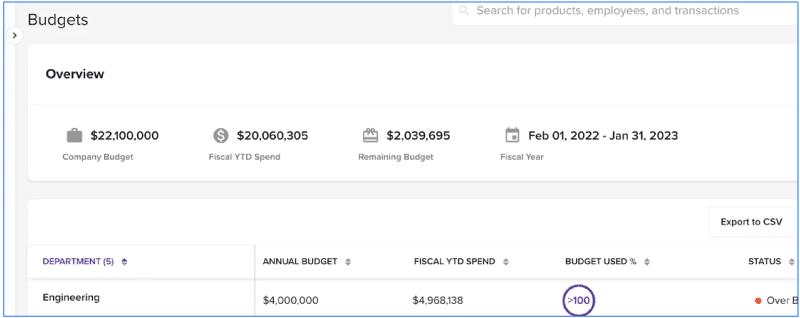Smart SaaS budgeting: Refine your spend strategy for 2024
April 25, 2024
7 minute read

Feeling buried by an app avalanche? You’re not alone. SaaS tools are fantastic, but keeping your tech stack from turning into a financial snowball can be tough.
Let’s break down smart SaaS budgeting, so you can make your tech work for you, without blowing the bank. Get ready to turn those monthly charges into strategic investments that fuel your business growth.
What is SaaS budgeting?
SaaS budgeting is the process of planning, allocating, and managing financial resources for acquiring and using Software as a Service (SaaS) solutions within an organization.
Crafting a SaaS budget requires attention to cost predictability, aligning with business goals, and agility to adapt to business needs. As organizations increasingly rely on SaaS solutions to power their operations, mastering the art of SaaS budgeting has become an essential skill.
Whether you’re new to SaaS budgeting or you’re a seasoned pro, there’s always something to learn about the best ways to buy software. Thanks to tools like BetterCloud, it couldn’t be simpler. This guide will go over the process of building a SaaS budget, common mistakes to avoid, and how BetterCloud can help.
Effective tips for SaaS budgeting
You’re probably not building a SaaS budget from absolute scratch. Chances are you already spend a good deal of money on SaaS and you’re in need of a serious reorganizing.
This step-by-step process will help you get a handle on your SaaS spend and guide you toward optimizing it.
1. Start with what you already spend
The first place to start is taking an inventory of what you already spend your money on. You likely already have a laundry list of SaaS subscriptions that have been around the company longer than you have. Spend some time familiarizing yourself with the software you already pay for.
SaaS budgeting checklist
In addition to the amount of money you already spend on SaaS, you should also check:
- Term lengths of your current contracts
- How many seats do you get for each application
- How often these applications are used
- Who manages the application for each department
This will give you a more clear snapshot of your SaaS situation. Maybe you’re spending the right amount of money, but you need more seats, or you might be paying for a service that nobody uses. These are the things you’ll discover when you take an inventory of your SaaS spend.
2. Loop in key stakeholders
Informed SaaS buying decisions rely on key stakeholders feedback.
Once you’ve pinpointed your key stakeholders in the first step, you can bring them into the conversation around reducing SaaS spend. Get everyone together and talk candidly about how much you currently spend on every application in your tech stack. Are you using too much or too little of your budget on these subscriptions? Be candid and open in your discussion.
No single department owns SaaS line items, which is why budgeting for SaaS is a cross-functional effort. It’s important to decide which employees in each department will handle the line items for their team and manage everything.
3. Plan your budget
While many will tell you how much to spend on SaaS, the truth is that only you can decide what the right number is.
According to a study by Foundry, IT decision-makers reveal that 31% of their budget will go toward cloud computing, and two-thirds expect their cloud budget to increase in the next 12 months.
Go with your gut. Ask yourself what programs you absolutely need to do your job the right way. Then figure out how much those programs usually run before finally deciding on a number. Focus on the functionality, not the finances. The right SaaS budgeting software will pay for itself.
4. Research your software options
Once you’ve pinpointed what software you need for the next fiscal year, it’s time to do some shopping. The first step in picking the right software is researching. A quick Google search, poking around on forums, and reading reviews can help you find the right software for your needs.
Software marketplaces that are particularly helpful include:
- G2
- Capterra
- Gartner
These marketplaces allow you to not only read reviews from real users that have used each product, but also compare popular software options.
5. Find and eliminate duplicate software
One of the biggest mistakes people make is having multiple software solutions that do the same thing. There are many software solutions that provide more than one function, and it’s crucial that you trim your SaaS spending down to only the essentials.
Here are a few ways you can eliminate duplicate software:
- Monitor which software solutions do the same thing
- Check if different departments use similar products
- Communicate across teams and offices
- Find underused software solutions
Eliminating duplicate services saves you money and frees up spend for new robust solutions. This is an important step to complete before purchasing anything new for your business.
6. Review current contracts
There’s a good chance you’ll be looking to switch SaaS providers before your current contract has expired. Reviewing your current contracts and planning on when to make the switch is important for your SaaS budgeting process.
Establishing a contract management process can help you stay on top of your SaaS budget. It helps you avoid missing deadlines, keeps track of the legal process, and ensures you’re getting the best deal possible.

Some companies like to use contract management software solutions for this process. Recently, SaaS spend management software solutions have begun including contract management in their platform to eliminate the need for duplicate services.
7. Invest in a SaaS spend tool
The real reason most people struggle with SaaS budgeting is that it’s too much information to track by yourself. From numerous user seats to countless account managers and a multitude of line items, keeping track of everything can be a monumental task. In fact, the sheer volume of data necessitates a dedicated employee, if your cash flow allows for it.
Most companies don’t have that kind of spend available. This is why many invest in a SaaS spend management tool like BetterCloud helps organizations streamline and optimize internal software spend, utilization, contracts, and compliance by effortlessly housing and visualizing your technology stack.
Everything is automated so that you can spend less time managing spend and more time doing your job. It’s a lifesaver for teams of any level. For start-ups, it allows you to put the little things on the back burner so that you can focus on hypergrowth. For enterprise companies, it tracks the complicated webs between departments, managers, and different offices.
8. Analyze and adjust
There’s a chance you don’t get things right on the first try, and that’s okay!
Maybe you thought you’d use a software solution more than you do. Or maybe you underestimated how many seats you’d need for SaaS software. Tracking your SaaS spending after you’ve made your purchases is crucial to optimizing your SaaS budget.
Ask yourself:
- Are we using these SaaS solutions enough to justify the cost?
- Is there a benefit to increasing our spend with a SaaS provider?
- Do we have enough seats for this SaaS solution?
- Could any of these products be classified as duplicates?
Adjust as you go. Remember, the right SaaS solution for your company today might not be the right solution three years from now. You need to keep an eye on how SaaS software grows with your company. Always be looking for ways to improve.
Tip: Wondering where to start to save on SaaS? Check out our mega-guide on saas savings.
Common SaaS budgeting mistakes to avoid
Your SaaS budgeting strategy will look different depending on the size of your company. While not every strategy works for every business, there is a wrong way to budget for SaaS. These common mistakes can set you back time and money, so it’s important to avoid them!
1. Don’t undersell or underestimate SaaS budget
One common mistake people make when creating a SaaS budget is not asking for enough money during the budgeting process. People often think if they ask for what they need, their request will get rejected. You cannot low-ball your forecast for SaaS spending. You get what you pay for, so be sure to ask for what you need!
One way to increase your chances of getting the budget you need is by doing your research. Come prepared with answers to these questions:
- What crucial business functions does your team perform, and how will this software help?
- How will this software make your team more efficient?
- What’s the ROI of investing in this software?
- Do your competitors use this or a similar software?
- What do other users say about this software?
If you can prove the business case of a certain SaaS to whoever is in charge of the budget, you are more likely to get what you want.
2. Don’t create your SaaS budget in a silo
The chances that you need software that nobody else in your organization might use is almost certainly zero. SaaS solutions are designed with multi-team use in mind.
That means if you don’t include leadership from other departments, you’re more likely to spend money on duplicate software solutions that waste money. Bring other teams into the conversation when budgeting for SaaS. There’s also a better chance of having your budget approved if more than one department can use it.
3. Avoid buying solutions that can’t grow with you
Don’t be tricked into purchasing a short-sighted software solution. You want to invest in SaaS that can grow with your company. The longer you can stick with a SaaS provider, the greater chance you have of becoming a valued customer. This can lead to better customer support, better deals on your contract, and more!
Think about where you want your company or team to be in three years. Will this SaaS solution be a good investment in the future? Plan ahead, and you can save yourself time and money when it comes to your SaaS budgeting.
How BetterCloud simplifies SaaS budgeting
With BetterCloud, you can integrate different financial and accounting platforms to identify your organizational spending. It provides full visibility into your tech stack, allowing you to discover the tools used across departments and how much you’re spending on each. BetterCloud alerts users to unusual spending patterns, which helps reduce the overall budget.

Once you’ve identified your software spending through BetterCloud’s financial and accounts integrations, you can allocate a SaaS budget to different departments. Allocations can be manual or automatic, depending on the headcount of users. BetterCloud will monitor which departments are consuming the most of your SaaS budget against their planned allocation based on the products you’ve mapped to each.
BetterCloud also simplifies budget ownership by identifying the right stakeholders. This empowers departments to enhance communication and call the right shots as and when required.
It’s time for SaaS-tainable savings
You’re ready to take what you’ve learned and start making better business decisions. A well-thought-out SaaS budget should allow you to make the most of cloud-based solutions while being financially smart and adaptable.
To fully optimize your SaaS spend for maximum savings, request a demo for BetterCloud today.






